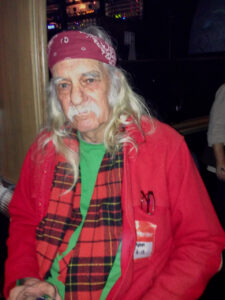
Jerry Kamstra (January 2, 1935 – November 26, 2019) was an American novelist, poet, artist and community organizer. Kamstra is best known for his novels Weed: Adventures Of A Dope Smuggler and The Frisco Kid. He was a prominent artist denizen and “Beatnik” of San Francisco’s North Beach neighborhood in the late 1950s and early 1960s, as chronicled in The Frisco Kid, his novel of the Beat Generation. The novel has become a cult classic which literary critic and Kerouac biographer Gerald Nicosia claims is “a Beat masterpiece on par with On The Road.” (From Daniel Yaryan’s 2019 obituary of Kamstra, which continues at bottom of page.*)
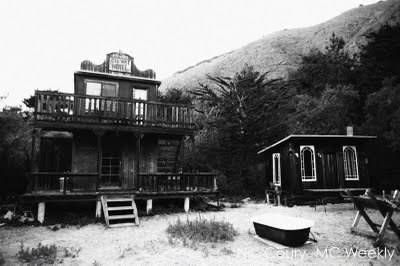
Novelist\artist Jerry Kamstra and his “literary outlaw” life—by Wallace Baine, Santa Cruz Sentinel
August 27, 2017. Reprint courtesy of Santa Cruz Sentinel.
SANTA CRUZ >> Sixty years ago, in the fall of 1957, a young former champion diver and basketball player from California’s Inland Empire arrived in San Francisco and, unwittingly, stepped into the slipstream of an emerging counterculture that carried him to a life of artistic adventure he never could have anticipated.
Jerry Kamstra had just been discharged from the U.S. Air Force, and Jack Kerouac’s “On the Road” had just been published. But Kamstra knew nothing about Kerouac. He had briefly visited San Francisco while serving in the Air Force and vowed to himself to come back when he was out of the service.
“All I knew was that it looked exciting,” he said. “When I came to San Francisco, it took me about a month to discover North Beach. I moved there and just started hanging out. But I was totally ignorant of the Beat Generation and the literature of the time.”
Eventually, however, Kamstra came to make a vital contribution to historical understanding of what exactly happened in North Beach in the heyday of the Beats.
“There were poetry readings in coffeehouses, parties. It was fantastic. Every night, we’d meet in Washington Square and say, ‘Where’s the party tonight? North Beach? Sausalito? Berkeley? Let’s get there!’ ”
The whole scene is brought to life in Kamstra’s 1975 novel “The Frisco Kid,” which is so true-to-life, in Kamstra’s view, that he playfully labels it “fact-ion,” a blend between fact and fiction. In many cases, the names weren’t even changed.
“When I wrote the first draft,” remembered Kamstra, “I used all the real names of people with the idea that I would come back later and change the names. But then, I came back and was like, ‘I’m not going to change these names. They’re too good!’”

At age 82, Jerry Kamstra, a longtime fixture on the alternative Santa Cruz literary scene, is the subject of a tribute, an event that will take place in Scotts Valley on Saturday, Sept. 2, 2017 to honor his work as a writer and artist and his example as a one-of-a-kind, freethinking proto-hippie and raconteur.
The event marks the grand opening of the “Kamstra Sparchive,” an archive of books, artworks, posters, photographs and other artifacts that collectively form a constellation of touchstones from Kamstra’s life and from the period just before the famously colorful 1960s counterculture hit the mainstream. The event will feature live poetry, prose readings and music, and will be hosted by well-known journalist/historian Gerald Nicosia, who wrote Kerouac’s biography.
The archive is the work of Santa Cruz writer Daniel Yaryan, who at 45 is a couple of generations removed from the Beats of Kamstra’s era. Yaryan’s deep interest in the Beat period has moved him to produce several events centered on the appreciation of the period including his poetry series “Sparring with Beatnik Ghosts” and the revival of the Santa Cruz Poetry Festival in 2012, an event co-produced by Kamstra throughout the 1970s.
Yaryan first met Kamstra at the Santa Cruz Flea Market in 2009. “He was there selling his books and his artwork,” said Yaryan. The two men sat down and talked for three hours, sparking a deep friendship. Part of the Sept. 2 event will be Yaryan’s presentation to Kamstra of a Lifetime Achievement Award.
Yaryan said that Kamstra has become a grandfatherly presence in his life. “He’s a literary outlaw,” he said. “It’s been one of those relationships where my enthusiasm is revitalizing him and his stories have my fed my enthusiasm.”
In the 1970s, Kamstra helped moved Beat poetry’s center of gravity to Santa Cruz with the Santa Cruz Poetry Festival, an enormous two-day bacchanalia of the written word, which featured many of the counterculture’s biggest names including William Burroughs, Lawrence Ferlinghetti and Allen Ginsberg. The first event, in 1972, sold out the cavernous Civic Auditorium. Kamstra produced five of the festivals over the course of the next decade.
Today, Kamstra is a man of stories — of literally falling to his knees to beg Burroughs to cut his fee for appearing at the Poetry Festival (it didn’t work), of watching Ginsberg parade naked through a post-festival party while Charles Bukowski yelled “You’re not a poet, you’re a nudist!”
His art hangs on the wall of his modest Live Oak apartment. He’s said that he’s a bit bedazzled by the attention being heaped upon him and his work by his much younger admirer. “It’s surprising,” he said, “but gratifying too. I’ve succeeded in becoming pretty unknown these days. You never know how you influence people until you get an accolade like this. My fame is a near-death experience.”
Jerry Kamstra Home: Santa Cruz
Occupation: Author of the novel “The Frisco Kid” and the memoir “Weed: Adventures of a Dope Smuggler.” Co-producer of the Santa Cruz Poetry Festival, throughout the 1970s.
Originally from: Grew up in Colton, a small town between San Bernardino and Riverside. A talented athlete as a youth, he was a regional champion as a diver from the three-meter board and later, while serving in the U.S. Air Force, tried out for the U.S. Olympic diving team.
Santa Cruz Poetry Festival: Was a co-producer of the Santa Cruz Poetry Festival, a major literary event that attracted national attention, featuring many of the biggest names of counterculture literature of the day. Five two-day festivals were presented in Santa Cruz in the years between 1972 and 1981. At the same time, Kamstra published “Weed,” an account of his years living in Big Sur where he earned money poaching abalone and smuggling marijuana from Mexico. He moved to Santa Cruz County in the mid 1970s.
by Wallace Baine
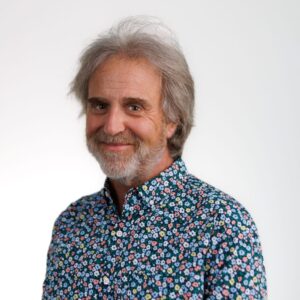
Baine has been influential on the Santa Cruz, CA community as a writer and advocate of the arts. He retired from the Sentinel in 2018 after more than 25 years.
Baine launched his full-time journalism career on a day Santa Cruzans will never forget: Oct. 17, 1989, the day the Loma Prieta Earthquake destroyed much of downtown.
He joined the Santa Cruz Sentinel in 1991 and established himself as the authoritative voice on music, movies, local art and entertainment and daily Santa Cruz life. His interviews, profiles and features form a living archive of recent history. Over the years, he has also written four books, and co-launched and led the top artist-recognizing Gail Rich Awards for 22 years. After leaving the Sentinel in 2017, he was the leading storyteller for the Good Times alt-weekly. He now reports and writes for Lookout Santa Cruz. (Bio adapted from Lookout Santa Cruz.)
Interesting side notes from J.Macon King:
In my MillValleyLit interview with author and screenwriter James Dalessandro (1906: A Novel), James told tales of organizing, with Kamstra, the 1972 original wild and crazy Santa Cruz Poetry Festival.
While interviewing late writer David Harris, I compared his 1981 book The Last Scam, about a Oaxacan dope smuggler, to real-life Kamstra’s Weed: Adventures of a Dope Smuggler. Harris replied, “Yes, right. I think I have that somewhere around here.” He went on to say that The Last Scam was also a true story but that Harris’ publisher safely labeled a “non-fiction novel.” Good idea, considering the controversy Kamstra’s book created.
Also, a character in The Last Scam is called “The Patchooli Kid”. Maybe he’s related to The Frisco Kid?
See Jerry Kamstra Reflections by J.Macon King here.
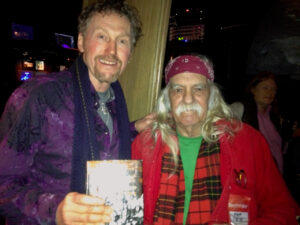
Beat author Jerry Kamstra on right with poet J.Macon King, while performing at “Beat at the Sweet” Kerouac Tribute, 2013.
*Jerry Kamstra Obituary continuation by Daniel Yaryan, long time close friend of Jerry’s.
Early Life: Jerry Kamstra was born January 2, 1935 in Riverside, California. Kamstra’s father, Richard “Dutch” Kamstra was a Dutch immigrant who made his living as a hard-rock miner, spending 50 years working underground. Dutch learned to speak English by reading The Katzenjammer Kids comic strip, arriving on a three-masted sailing ship in San Francisco in 1928 from Holland. Dutch became a member of the IWW (International Workers of the World) as a longshoreman. Dutch moved to southern California, and among his first jobs down there was milking cows for author Edgar Rice Burroughs in Tarzana, California. Kamstra’s mother, Lexie Kamstra, was the daughter of a fruit tramp, Nettie Cody, a distant relative of Buffalo Bill Cody. Jerry had three siblings – two brothers Richard Kamstra and Robert Kamstra; and one sister Bessie Kamstra.
By the time he was 14 years-old, Jerry Kamstra had broken his arm four times and had read most books in the Colton Public Library. From an even younger age, Kamstra was an avid sportsman which later culminated into a position of captain of the third best high school basketball team in California. He was also a diver specializing in the 3-meter board, becoming champion of the Inland Empire and, while a member of the United States Air Force, he tried out for the 1956 Olympics.
Kamstra worked with his father as a miner shortly after graduating from Colton Union High School in 1953. He received a full fellowship to ArtCenter College of Design in Los Angeles where he moved in the fall of 1953. Kamstra was studying to be a cartoonist, but after two semesters in art school, he quit to join the U.S. Air Force in 1955 to see the world. He was stationed in Guam. In 1957 he was busted and sent to the military stockade for a month for disobeying an order to march in a military parade, whereas he instead went skin diving in the deep waters of Guam.
Jerry Kamstra was given an honorable discharge from the Air Force in late 1957 under family hardship conditions after 2 ½ years of military service. His father was injured in a mining accident. Since Kamstra’s mother was already disabled in a wheelchair, he went home to help his family until his father recovered from his accident.
After leaving the U.S. Air Force and assisting his family, Kamstra took his first trip to Mexico and was turned on to the country. He met a girl named Anno on Isla Mujeres, where they made love in a Mayan temple amidst 6-foot iguanas staring at them.
At the tail end of 1957, Kamstra moved to San Francisco and “discovered a community existing on the edge of the city unlike any other in America. Reckless, creative, frenetic, insane, it was too insane for a lot of people, for not many survived,” said Kamstra. “I did, however, and in surviving came of age in the cheap pads and artists’ lofts in North Beach. In the process I lost my innocence and my youth, but gained an indelible memory of a bunch of crazy people who lived, fought, struggled, loved and even died together with a sense of élan and community that I had never experienced before nor have found since.”
Jerry Kamstra was married twice and is father to four children: Ameliana Kamstra, Duke Kamstra, Tcherek Kamstra and Miakje Kamstra. He has four grandchildren: Kaitlyn Thompson, Madison Kamstra, Mio Kamstra-Brown, and Tyler Kamstra,
North Beach life: From his novel The Frisco Kid: “San Francisco is not America; it’s what’s left of America. It’s the Great Wall of China of America’s forgotten promises! Here in San Francisco have gathered all of society’s children, space-age dropouts from the American dream, Horatio Algers in reverse, descending from riches to rags and gathering now on the corners of Grant and Green in their beads and spangles and marijuana smoke to watch the entire structure crumble.”
In reference to the preceding quote from The Frisco Kid, Anthony Ashbolt[1] of the University of Wollongong, Australia, stated, “Kamstra’s words reverberate with imagery from the 1960s, yet they are from a novel about Beat life in San Francisco during the Fifties. The passage is but one example of the way in which the city has been marked out as different, as a refuge, a depository of discontent and cauldron of rebellion.” Kamstra co-owned Cloven Hoof Bookstore on Grant Avenue in North Beach, San Francisco, from 1959-1960. At that time, Kamstra organized a rally against police brutality of North Beach artists and Beats, the first protest of the 1960s in Washington Square Park on January 15, 1960. Also speaking at the protest were Beat poets ruth weiss and Bob Kaufman.
Kamstra was arrested in the HUAC (House of Un-American Activities Committee) riots at San Francisco’s City Hall in May 13, 1960 while taking photographs of the riots. He resisted arrest, landing photos of him on the front page of numerous local newspapers, including one with the caption “Novelist netted” in the San Francisco Call Bulletin.
From the Cloven Hoof Bookstore, Kamstra designed, published and sold his first book Forbidden Limericks in 1959, collected by C.V. J. Anderson. The book became a best-selling staple of his bookstore with over 100,000 copies sold. He also published the last edition of Underhound magazine in 1960, volume 1, number 4, with an emphasis on local Beat poets, originally founded by Beat and surrealist poet Bob Kaufman. Kamstra illustrated these books under the pseudonym Shem The Penman.
In the summer of 1960, Kamstra sold his half of Cloven Hoof to his ex-girlfriend in order to move to New York City’s Greenwich Village to start his first novel Tom Fool. Kamstra used proceeds from the sale of Forbidden Limericks to survive and write. While in Greenwich Village, Kamstra met Beat poet Jack Micheline on a park bench in Washington Square, a friendship that would extend to North Beach and span the rest of their lives.
Career: Kamstra wrote articles, reviews and feature stories for numerous periodicals, including San Francisco Chronicle, San Francisco Bay Guardian, San Francisco Examiner, High Times, Scanlan’s Monthly, Beatitude magazine, Desperado and Good Times. Kamstra’s first published article was a homage to Beat novelist Jack Kerouac upon his death which appeared in the San Francisco Sunday Examiner & Chronicle in October, 1969, followed up with an article in the same publication November 16, 1969 titled “Jack’s ‘Road’ was the Beat Children’s Beacon”[2] That same year, Kamstra went to Taos, New Mexico to interview actor, producer and director Dennis Hopper, who had just made the film Easy Rider, for an article assignment for Scanlan’s Monthly, published by Warren Hinckle, political muckraker of the Gonzo journalism genre. Hinckle’s controversial magazine quickly brought heat from the FBI for lambasting the Nixon administration, so some of Kamstra’s articles were published under the pseudonym Roger Tichbourne to evade possible federal prosecution of the author for marijuana smuggling.
During his time as a marijuana smuggler from 1966 to 1972, Kamstra sold his story of “Gringo Smugglers” first to Life magazine, who paid him a large advance on the story but refused to publish it once they realized he was the actual gringo smuggler documented in the story. Then Look magazine bought the article, yet reconsidered publishing it because it was too hot for their readership.
An article published in Scanlan’s Monthly led to Kamstra’s novel Weed: Adventures Of A Dope Smuggler (Harper & Row, hardback edition, 1974 and Bantam Books paperback edition, 1975). The novel has been optioned by Hollywood producers five times in attempts to make a movie. The first option was from producer Tim Zinnemann in 1974 – intended to star actor Richard Gere in the lead role. Weed sold over 200,000 copies between the Bantam Books and Harper & Row editions combined.
The success of Weed paved the way for the publishing of his novel The Frisco Kid (Harper and Row, 1975), which was heralded as the “San Francisco novel of the year” by critic William Hogan of the San Francisco Chronicle upon its release.
Famous columnist Herb Caen called it “Intensely readable…a picaresque, Saroyanesque celebration of life in the North Beach netherworld.” Kamstra’s friend, poet Lawrence Ferlinghetti owned a cabin in Big Sur, California where Kamstra wrote most of The Frisco Kid. The cabin was also a renowned retreat for other famous authors, most notably Jack Kerouac.
Santa Cruz Poetry Renaissance: In addition to being a marijuana smuggler, artist and novelist, Kamstra worked as an abalone and salmon fisherman, a club manager for Big Brother & The Holding Company and a construction worker. He was also a community organizer of literary events from San Francisco to Big Sur, California, including the popular Santa Cruz Poetry Festivals. There were five festivals at the Santa Cruz Civic Auditorium, spanning from 1972 to 1981, which were the largest poetry festivals in the United States. [3] Kamstra was involved with all five of these festivals, and was director of two of them – the 2nd Santa Cruz Poetry Festival “Benefit for AIM-J (Americans In Mexican Jails) on November 25, 1974 and the “Fifth Annual Poet Tree Festive All” on November 13-14, 1981.
Kamstra started the AIM-J organization and 30 American prisoners in one of Mexico’s most notorious prisons received some “getting by” money as a direct result of the AIM-J poetry benefit held in Santa Cruz Nov 25. “The reading itself was one of the more exciting events to hit Santa Cruz since the invasion scares of World War II,” said Sam Silver of the Berkley Barb. [4], referring to the bomb scare that took place at the Santa Cruz Civic Auditorium while Allen Ginsberg recited his poetry to a crowd of 1,600 people. Also performing at the 1974 festival were Charles Bukowski, Linda King, Lawrence Ferlinghetti, Gary Snyder, jazz musician Charles Lloyd and a full-slate of “the biggest names in verse” according to Silver.
The “Fifth Annual Poet Tree Festive All” of 1981 was a two-day event that showcased Lawrence Ferlinghetti, Amiri Baraka, Gregory Corso, Bob Kaufman, Wanda Coleman, Ishmael Reed, Diane DiPrima, Lorna Dee Cervantes, William Everson and many other performers. Kamstra opened the festival reading Henry Miller to the musical accompaniment of Max Hartstein’s 25th Century Jazz Ensemble.
Three decades later, after taking young poet and “Sparring With Beatnik Ghosts” (SWBG) literary series founder Daniel Yaryan under his wing, Kamstra inspired Yaryan to bring the poetry festival back to Santa Cruz at the Cocoanut Grove Ballroom on February 12, 2012. [5] Kamstra’s artwork was showcased in several of the SWBG Anthologies, including as the featured artist of Volume 1, Number 4. SWBG published The Buzz From The Bees in its Volume 1, Number 3 Anthology, February 2010 — here’s an excerpt:
“At Cape Canaveral they sprayed the mosquitoes to make them dead. Yes they did. And they killed the bird it is said, that when it’s dead, even God would count the least of its head – and it’s dead. Yes, it’s dead. The last Dusky Sparrow is dead.”
In 2015, SWBG and its umbrella organization The Mystic Boxing Commission created an archive for artwork, books and memorabilia related to the SWBG series at the Old Sash Mill complex in downtown Santa Cruz. This archive, dedicated to Kamstra, is known as the Jerry Kamstra Sparring Archive. “The Sparchive” (as it is also called) also had a location in Scotts Valley, CA and is now located in the NoHo Arts District of Los Angeles, CA. Events continue to be held at the Sparchive in Kamstra’s honor.
Henry Miller and Big Sur: In 1990, Kamstra was chosen as the first director of the Henry Miller Memorial Library in Big Sur, California. While director, he published the first two editions of the HMML (Henry Miller Memorial Library) Review. In 1991, Kamstra’s Peeramid Press designed and published Henry Miller: The Paris Years by Bob Cross. Miller is the most influential author on Kamstra’s writing career.
Writing influences: Among Kamstra’s writing influences are Tropic of Cancer (Henry Miller), Ulysses (James Joyce), On The Road (Jack Kerouac), Maltese Falcon (Dashiell Hammet), Look Homeward, Angel (Thomas Wolfe), Walk On The Wild Side (Nelson Algren), This Side Of Paradise (F. Scott Fitzgerald), The Ginger Man (J.P. Donleavy), Walden (Henry David Thoreau), The Complete Poems of Emily Dickinson and Cry The Beloved Country (Alan Paton).
• Bibliography:
• Weed: Adventures Of A Dope Smuggler (Harper & Row, 1974, New York)
• The Frisco Kid (Harper & Row, 1975, New York)
• Santa Cruz Poetry Festival Anthologies (PeerAmid Press, Santa Cruz, 1975-1981)
• Stand Naked and Cool Them (PeerAmid Press, Santa Cruz, 1982)
• The Holy eARTh Journal (PeerAmid Press, Santa Cruz, 1983-1997)
• Don’t Kid Around With Jellybeans (Written and illustrated, PeerAmid Press, Santa Cruz, 1984)
• The Poet Tree (Written and illustrated, PeerAmid Press, Santa Cruz, 1988)
• The Littlest Christmas Tree (Written and illustrated, PeerAmid Press, Santa Cruz, 1989)
• Satori In Santa Cruz (PeerAmid Press, Santa Cruz, Don’t Kid Around With Jellybeans (Written and illustrated, PeerAmid Press, Santa Cruz, 1984)
• The Poet Tree (Written and illustrated, PeerAmid Press, Santa Cruz, 1988)
• The Littlest Christmas Tree (Written and illustrated, PeerAmid Press, Santa Cruz, 1989)
• Satori In Santa Cruz (PeerAmid Press, Santa Cruz, 1996)
• The Last of the Bohemians (Collectible edition, Roger Jackson, Anarbor, Michigan, 1998)
• The Buzz From the Bees (Sparring With Beatnik Ghosts, Santa Cruz, 2010)
• Big Sur & The Sour Grapes of Henry Miller (Sparring With Beatnik Ghosts, Santa Cruz, 2016
References:
Ashbolt, Anthony, Bohemians, Bridges and Bolsheviks: Radical San Francisco Before Flower Power, Illawarra Unity – Journal of the Illawarra Branch of the Australian Society for the Study of Labour History, 11(1), 2012, 27-50. Available at:http://ro.uow.edu.au/unity/vol11/iss1/3
2. Kamstra, Jerry. “Jack’s ‘Road’ was the Beat Children’s Beacon,” SAN FRANCISCO SUNDAY EXAMINER AND CHRONICLE, 16 November 1969, This World section, 51
3. Santa Cruz Sentinel, November 13, 1981.
4. Berkeley Barb, December 6, 1974
5. Santa Cruz Sentinel, February 13, 2012 – “Back in rhythm: Poetry Festival returns after 30-year absence”: http://www.santacruzsentinel.com/article/ZZ/20120212/NEWS/12021758
On behalf of the Kamstra family, thank you to Daniel Yaryan (long time close friend of Jerry’s) for this write-up.
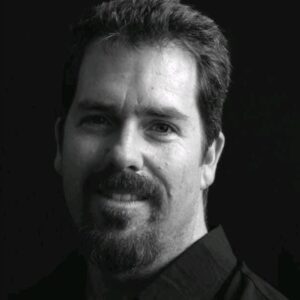
About Daniel Yaryan
Co-founder of the Mystic Boxing Commission, Daniel Yaryan is a poet, writer, graphic designer, publisher and event producer. He founded Sparring With Beatnik Ghosts, resurrected Poetry Festival Santa Cruz in 2012 and was regarded by the late Los Angeles poet Wanda Coleman as “one of the new generation of poetry mavens.” Yaryan is a devout disciple of the late poet William Everson (AKA Brother Antoninus, the “Beat Friar.”) and he lives in Santa Cruz, California with his daughter Hannah and son Andy. Go to http://www.sparringartists.com/ for more info.
Quick Links:
The 10th plus 1 Anniversary of “Beat at the Sweet.” A Beat Poetry Reading (and music) in Tribute to Jack Kerouac & movie release of On the Road at Mill Valley CA. Sweetwater Music Hall Jan. 8, 2013:
Remembering “Literary Outlaw” Jerry Kamstra by Wallace Baine.
Jerry Kamstra Obituary by Daniel Yaryan.
Reflections on Jerry Kamstra by J.Macon King.
THE LAST BOHEMIAN WIZARD (in honor of novelist Jerry Kamstra) by Daniel Yaryan.

And then there was this time…
Poems and kind words by Ari M. Maslow upon the occasion of 10th plus 1 Anniversary of “Beat at the Sweet.”